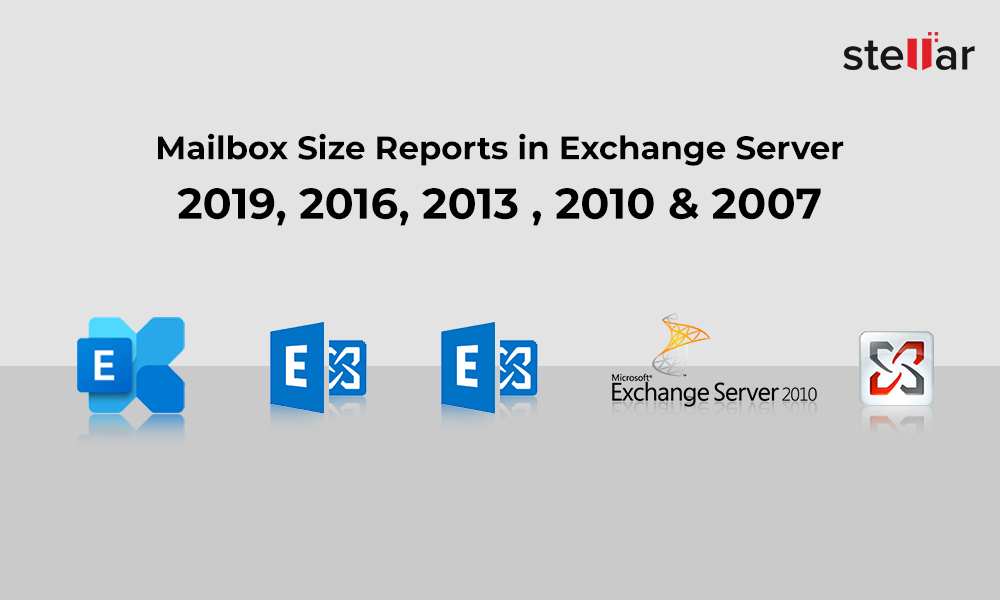

- Mailbox size exchange 2010 how to#
- Mailbox size exchange 2010 software#
- Mailbox size exchange 2010 windows#
$Result | Export-CSV “C:\MailboxSizeReport.Testing Room Mailbox In Exchange Server 2016 How To Create Resource Mailbox and Shared Mailbox in Exchange Server 2016 Distribution Group Vs Security Group in Exchange Server 2010 in Hindi - Part 69 7. Aisha Bhari 0 B (0 bytes) 190.4 KB (194,983 bytes) Aleisha Harrison 0 B (0 bytes) 142.4 KB (145,797 bytes) If we wanted to know the total size of all of those mailboxes we could output the data to CSV file, import it into Excel, and use formulas to get the results. If you are using Outlook 2010 or later, your quota and current mailbox size is.

StorageSizeLimit = $mbx.ProhibitSendQuota How to view your Mailbox size and Exchange quota in Outlook &038 OWA. For example, to list the sizes of all mailboxes on a particular database we can use this command. UserPrincipalName = $mbx.UserPrincipalName The Exchange Management Shell, powered by PowerShell, makes it easy to collect size information for the mailboxes in an Exchange 2010 organization. First, choose the View Mailbox Size option which scans the size of your mailbox and all of the subfolders. In Outlook, choose File > Info > Cleanup Tools > Mailbox Cleanup. The best place to start is to open the Mailbox Cleanup tool. $Result += New-Object PSObject -property = $mbx.DisplayName The following steps apply to Microsoft Outlook 2016, Outlook 2013 and Outlook 2010: 1. Exchange 2013 you can click on the little gear icon, found in the top right corner on the left hand side of Name > Options > Account. $size = ::Round(($().Split(‘(‘).Split(‘ ‘).Replace(‘,’,”)/1MB),2) Exchange 2007 and Exchange 2010, you can simply hover over the name of the mailbox and a little Tool Tips will appear and show your current mailbox size and quota. If a mailbox database grows beyond this limit, the database automatically dismounts. Write-Progress -activity “Processing $mbx” -status “$i out of $totalmbx completed” The default database size limit for Exchange 2010 Service Pack 1 Standard edition is 1024 GB.

To ensure that users do not exceed the specified mailbox size that was used to size the overall system, we can set mailbox storage quotas. $mbs = Get-MailboxStatistics $mbx.UserPrincipalName Figure 1-1: Sizing an Exchange 2010 Infrastructure for 1GB Mailboxes. Can you try the below = Get-Mailbox -ResultSize Unlimited The following article describe how to create Mailboxes size report/s in Exchange 2010. For this, select the Email Scheduled Report checkbox and enter the email addresses.
Mailbox size exchange 2010 software#
The software also allows you to send the report to specific email addresses.

The cmdlet below will show you how to get a Mailbox Folder statistics for specific user, the cmdlet will also sort the folders by Folder size when the largest folder size will be on the top of the list. The retention policy field comes with Get-Mailbox command. You can save the Exchange 2010 mailbox size report and the mailbox size reports of other Exchange versions in different formats such as PDF, HTML, CSV, and XLSX. How Get User Mailbox Folder Sizes Report Exchange 2010 2013. Not bad, but better than what we have in the Exchange 2007 GUI. In case you are not comfortable with GUI, simply use this command to change the Mailbox size: Here, the exception will be made in the mailbox of a user named Alice and the new mailbox size will be 25 GB. Get-MailboxStatistics -Server 'ExchSVR1' | Where , In earlier versions of Exchange, we could look in the Exchange console and see mailbox sizes on a per database basis. Reconfigure Mailbox Size in Exchange 2016, 2013, 2010, 2007 using PowerShell Command.
Mailbox size exchange 2010 windows#
Use the below powershell script to get mailbox size of all the users. This tutorial demonstrates the step by step process for how to backup and restore an Exchange Server 2010 Mailbox Database using Windows Server Backup. To make finding this vacant slot much easier, room list distribution. This feature is designed to help the user in scenarios where the calendars of multiple resource mailboxes must be examined when attempting to find a vacant slot in a resource mailbox calendar. To get malibox size of all the users, you need to give exchange server name as input paramater instead of user identity. Exchange 2010 includes a fantastic new feature called room list distribution groups.


 0 kommentar(er)
0 kommentar(er)
